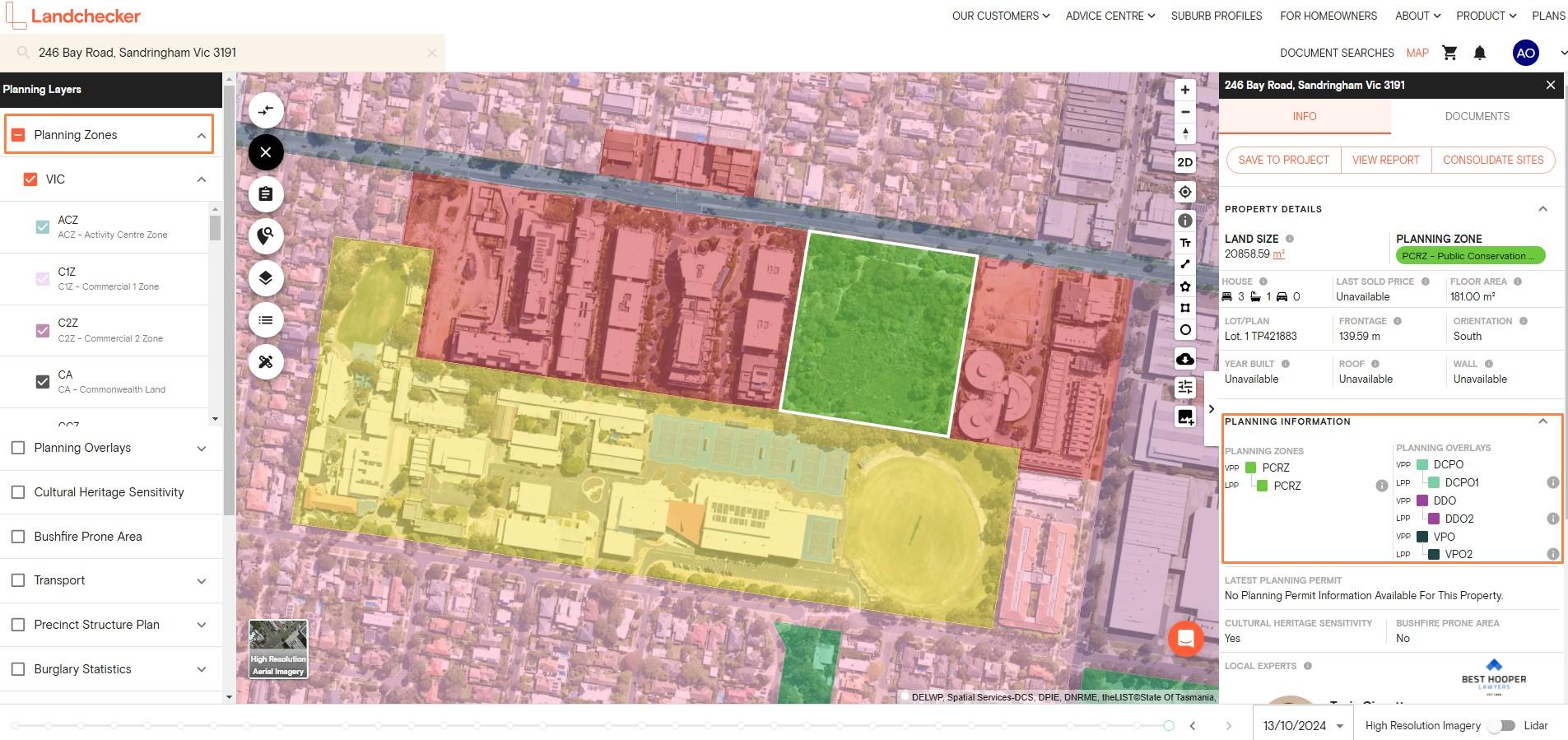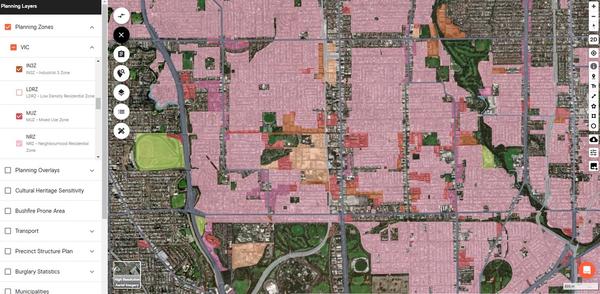Articles
What You Need to Know About Land Zoning And Zoning Maps in Australia
Land zoning in Australia can be complex but understanding it and having access to zoning maps is essential to determining a site's potential uses and development possibilities.
It also helps stakeholders comply with the intended use of a specific property when starting a new project to avoid unnecessary penalties.
To help you ensure the success of your next project, we’ll explore land zoning and zoning maps. In this article, we’ll share why zoning maps are important, the common types of land zones, and how you can access a comprehensive zoning map on Landchecker.
What is Land Zoning in Australia?
Land zoning refers to the rules, regulations and state or local laws that are put in place to control how a specific parcel of land or property can and cannot be developed. It also determines whether a specific land or property can be used for residential, commercial, agricultural or industrial purposes, among others.
The Importance of Zoning Maps
Many property professionals and homeowners find obtaining land zoning information challenging since zoning rules in Australia are established based on the state or territory where the specific property is located.
Landchecker provides consolidated data on land zoning and zoning maps in states such as NSW, VIC, QLD, WA, SA, Tasmania and ACT. Each state and area will have its own land zoning and zoning map information.
Who Uses Zoning Maps?
Zoning data is used by property professionals such as:
Developers
Town planners
Architects
Builders
Real estate agents
Legal advisors
Trades such as fence, pool and shed builders
Even homeowners or buyers interested in property renovations or purchases rely on zoning maps to understand what they can and can not do with their property.
5 Common Types of Zoning Categories in Australia
Each state in Australia has different types of land zoning categories and uses different land zoning codes. Here are some of the general zoning categories found on zoning maps.
1. Residential Zones
Residential zones are single-family residences, duplexes, townhomes and multi-family buildings. This zone is for housing developments with a certain maximum building height set by the state government.
Depending on the state or council, this zoning category can be further classified into:
General Residential: Standard residential use with moderate density.
Low-Density Residential: Sites with larger lot sizes and fewer housing units.
High-Density Residential: Areas with multi-family units and apartment complexes.
2. Commercial Zones
Commercial zones are land or properties dedicated for use by different types of businesses. These are located in commercial strips and are often used for offices, retail spaces and entertainment venues.
Commercial zones can be further categorised into:
Central Business Districts (CBDs): Areas with high-density commercial areas in city centres.
Local Commercial Zones: Locations designated for small businesses serving the local community.
Mixed-Use Commercial Zones: Spots that combine residential and commercial uses, promoting a vibrant community feel.
3. Industrial Zones
An industrial zone is designated for property developments that require heavy and light manufacturing, such as factories, warehouses and other industrial activities. Industrial zones are placed far from residential zones to minimise environmental and noise impact.
Industrial zones can be classified as:
Light Industrial: These zones are made for small manufacturing businesses or logistics centres that produce minimal noise or pollution.
Heavy Industrial: Zone dedicated to large-scale manufacturing and heavy industries that need large spaces and have a greater environmental impact.
4. Agricultural and Rural Zones
Agricultural and rural zones are types of land zoning created to protect land that is used for agricultural purposes. These zones are mostly located in places that aim to maintain the farm industry’s economic viability by limiting non-agricultural development in the area.
Agricultural and rural zones can be broken down further into specific categories such as:
Farming Zone (FZ): Areas created to protect farmland and ensure sustainable agricultural practices.
Rural Conservation Zone (RCZ): Protects rural land with high environmental significance.
5. Environmental and Special Purpose Zone
Environmental zones protect land or properties with important environmental value. If there are land uses that cannot be added in other zones, these sites are tagged as special purpose zones.
Environmental and special purpose zones were created to allow low-impact housing in environmentally significant areas, preserving bushland and ensuring buildings suit their natural surroundings and bushfire safety.
Environmental Living & Green Wedge Zones: Non-urban land areas designated to protect agriculture, natural resources and landscapes.
Special Purpose Zones: Cemeteries, educational establishments, water supply areas and other sites requiring special management arrangements.
Environmental Protection Zones: Any protected areas, such as national parks, botanical gardens and national heritage sites.
How Zoning Maps Support Property Decision-Making
It’s important to understand the permitted land use before purchasing or developing a property to avoid costly mistakes that could lead to project delays or potential fines.
Here’s how having access to land zoning information and zoning maps can support the property decision-making process for professionals and homeowners:
1. Development Planning and Site Selection
During the development planning and site selection process, having access to accurate zoning maps is necessary to get a clear overview of the permitted land use for a certain site. This includes the site’s buildable area, building heights and specific uses per floor.
By being able to access this information, property developers and homeowners can avoid areas with restrictive zoning regulations.
2. Permit and Regulatory Compliance
Each zone has different permit requirements and regulatory compliance. This is why it’s important to know the zoning category of your chosen site for a smooth permit application process.
Zoning maps show the permitted uses and overlay controls of a land or property. This makes it easier to comply with local planning regulations and identify potential requirements for special permits or rezoning applications.
3. Community and Environmental Impact
Understanding the existing zoning restrictions plays a major role in preserving the environment and protecting communities from noise, air pollutants and other negative health impacts.
Zoning maps assist property developers in planning projects that align with community objectives, reduce environmental risks and comply with heritage or conservation requirements.
4 Must-Have Features of a Comprehensive Zoning Map Tool
To make the most of zoning information, a reliable zoning map tool should include the following features:
1. Search and Visualisation Capabilities
When searching for a comprehensive zoning map tool, it’s important to consider the tool’s search and visualisation capabilities. This includes having the ability to access property boundaries, zoning overlays and land size data.
Platforms like Landchecker provide an interactive map where customers can search by address or suburb to check a property’s zone type and link to the planning scheme to research the zone further.
2. Permit and DA Alerts
Having access to setting up alerts for changes in planning permits or new development applications is invaluable for different stakeholders.
Permit and DA alerts help property developers, real estate agents and homeowners stay updated on potential changes that could affect their projects, such as pending, approved or rejected permits, as well as the planning history of a property.
3. Aerial and High-Resolution Imagery
Detailed satellite imagery assists planners and investors in assessing potential investments by visualising the land’s layout and surrounding environment.
High-resolution images clearly show the physical characteristics of a site as well as plot size, shape and land zoning without having to travel long distances to visit a site.
4. Mobile and Desktop Access
Mobile and desktop access is an essential feature for any modern zoning map tool. It allows users to access zoning data on the go, whether they're in the field assessing a site or at the office conducting research.
This flexibility ensures that property professionals or homeowners can make timely and informed decisions anywhere, anytime.
How to Check Land Zoning Through Landchecker
There are three ways to check a property's planning zone on the Landchecker map. You can use the right-hand side panel, the Planning Layers menu on the left-hand side or download a property report.
1. Search a property address on the map using the search bar.
2. The Information Panel on the right-hand side of the screen lists the planning zone(s) on the property, as well as a direct link to the planning scheme schedules.

3. Planning Zones can also be activated and filtered on the map under the 'Planning Layers' on the left-hand side of the screen and selecting 'Planning Zones'.
Sign up today to access Land Zoning & Zoning Maps
Search addresses to find their land zoning information on Landchecker
All Property Reports downloaded from Landchecker also include a full summary of planning information relative to a property, including planning zones.
Understanding land zoning and using zoning maps effectively are essential for anyone involved in property transactions or development.
By providing comprehensive zoning data across Australia, Landchecker helps simplify this process, making it easier for users to access critical information, avoid potential pitfalls, and make informed decisions.

